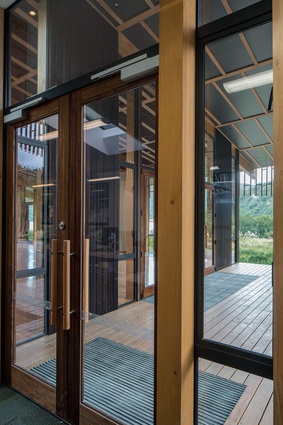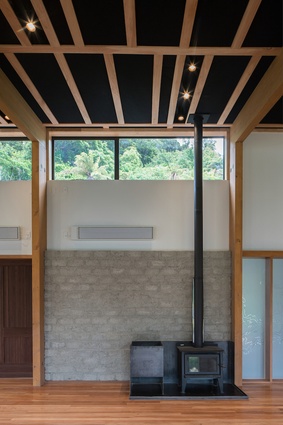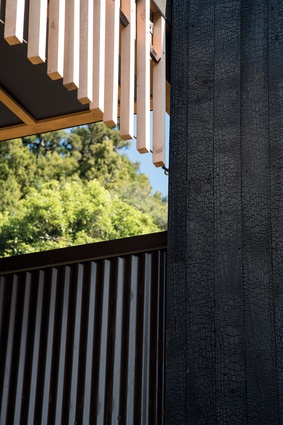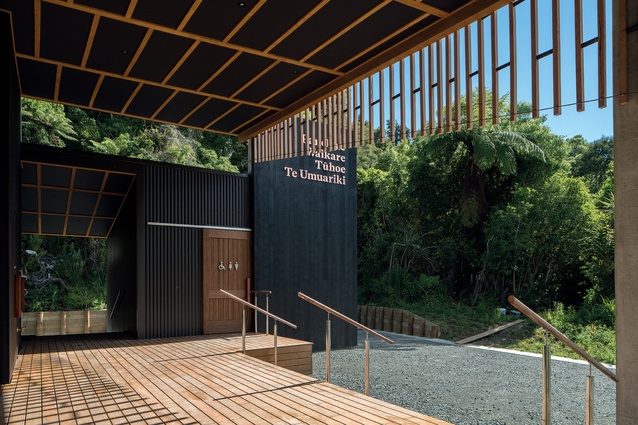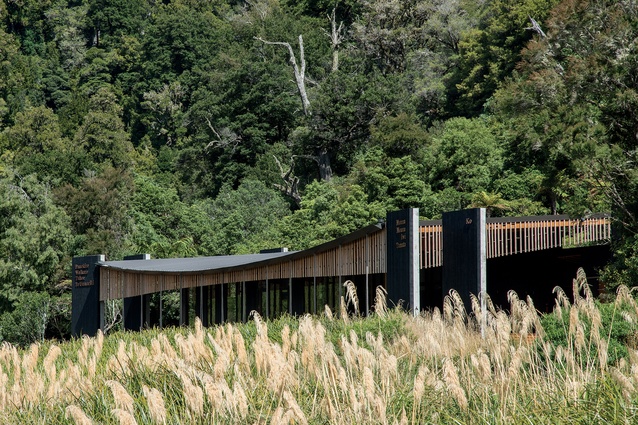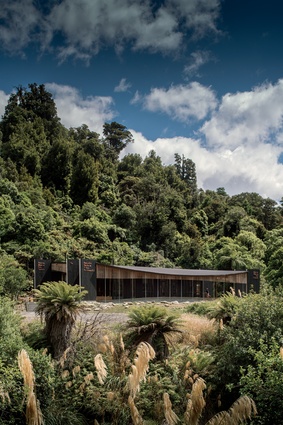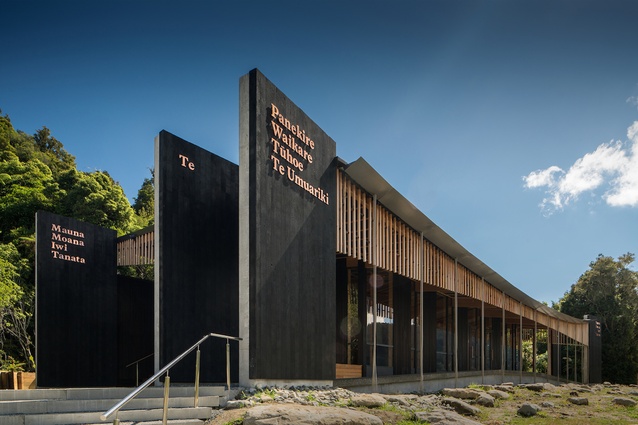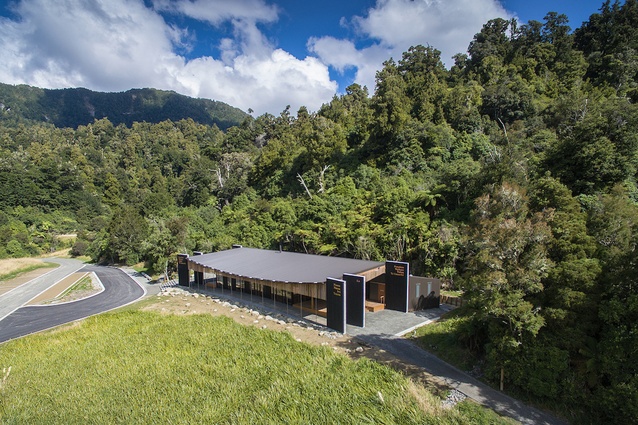Te Wharehou o Waikaremoana
Designed by Tennent Brown Architects, Lake Waikaremoana’s new visitor centre returns local iwi to its ancestral home beside the lake.
Few people in the architectural profession will have missed the controversial news of the demolition of Āniwaniwa, Lake Waikaremoana’s former visitor centre, by the Department of Conservation (DOC)1 last year. Sited about 2km from where this newly-completed visitor centre now stands, the Category 1 Historic Place-listed building (1976), designed by New Zealand’s first registered Māori architect John Scott, had more or less been left to degrade to an uninhabitable state over the past decade.
Understandably, many members of the profession were keen to have the building fully restored and to retain such an important piece of our architectural history. There were protests and petitions to save Āniwaniwa but the profession lost the battle.
However, there is now a story to be told about the new visitor centre, Te Wharehou o Waikaremoana, which is providing local iwi, Ngāi Tūhoe,2 with hope for the future of this southernmost part of Te Urewera. Te Urewera is a 2,127km² area of mostly forest and was considered to be the largest of four National Parks in the North Island until 2014 when it was made its own legal entity.
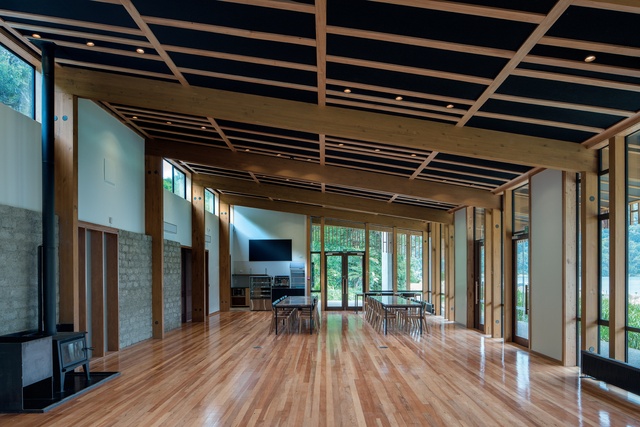
“This is our homeland but it is not owned by the Crown or Tūhoe,” explains Lorna Taylor, director chair at the Waikaremoana Tribal Authority. “This is the closest we have to what our old people had. We belong to the land but we don’t own the land. We wanted a place to be tangata whenua (people of the land),” says Taylor.
“This is a political act; it draws people to Te Urewera. We want people to understand this place through our eyes. Anybody can pop in. It’s a gateway to the southern end of Te Urewera and caters for 70,000 people each year, which will no doubt grow.”
The 2014 legislation attracted international attention, making Te Urewera of particular interest to indigenous peoples and nature lovers, drawing even more visitors to the area. The Waikaremoana Tribal Authority (WTA) is one of four rohe (district) communities within Ngāi Tūhoe and represents the marae and hapū (tribes) of the lake area, looking after a large geographical area that stretches from Puteri, inland north of the Napier–Taupo road, over to the Gisborne area.
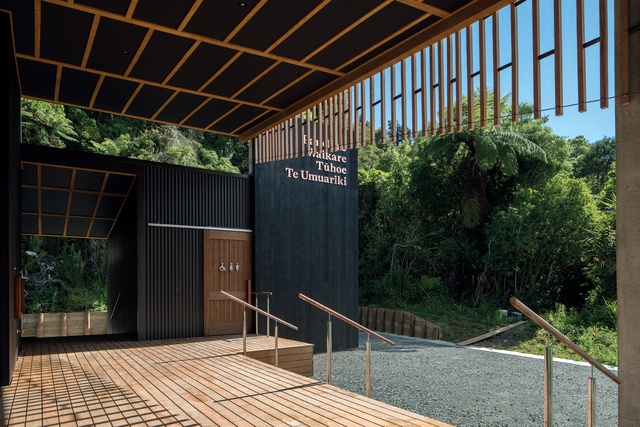
Taylor and WTA chairman Lance (Dana) Winitana warmly welcome me into Te Wharehou and we discuss their connection with Waikaremoana. “Our ancestors lived here around the lake, so this [building] was a return of Tūhoe back into the lake area where our ancestors once lived,” says Winitana. “Understanding our history, you’ll find that due to Crown invasion and alienation, our people were removed from the lake,” states Taylor. “Therefore, the two maraes which we now occupy are 20 minutes away from this point. Our ancestors were dotted around the lake foreshore and our great-grandparents lived here.”
Winitana believes that the Crown had its own reasons for forcing their ancestors away from the lake: “When they saw the lake, the Crown had a vision that, in time, because there were no jobs here, our fathers and mothers would go out and get jobs and we would be brought up in another area and, naturally, we’d stay there because we wouldn’t know this place. Then, in time, the older people would die off, rates would be created and there would be nobody here to pay because our generation wouldn’t want to come back. Then the Government would move in and take all rated lands… and that was the whole thing about that – but it failed.”
Taylor adds: “It’s like an induced amnesia to be removed from your land and then removed further into the urban drift so you eventually forget who you are. But that’s not how we’re made. There’s always a calling to come back to where you originate and we find that there are always people who want to know how they connect back to Waikaremoana, back to Tūhoe, back to Te Uruwera.”
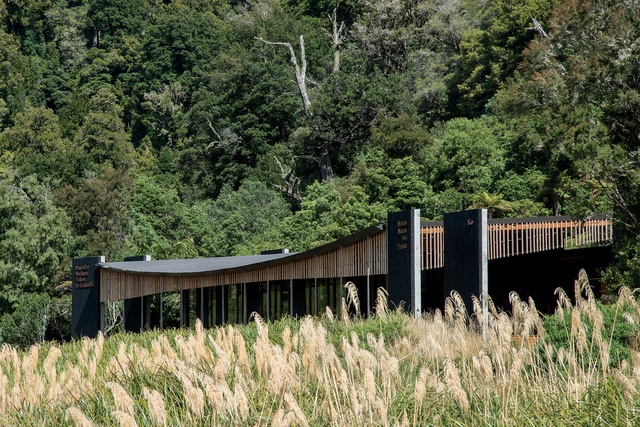
Historian Dr Vincent O’Malley states the situation more frankly: “The battle for control of Lake Waikaremoana was merely one instalment in a much longer saga of conflict with the Crown in the region.” During the 1860s, Crown forces adopted a “systematic scorched-earth policy around the shores of Lake Waikaremoana, torching all homes and cultivations in the area,” he says.
“Hundreds of Māori throughout the Urewera district were said to have died of starvation as a result. Hungry and homeless, the remainder had put down their arms by the early 1870s, encouraged by promises that the Crown would allow them to continue to control their own lands and other affairs, through institutions of their own choosing.”3 This promise had its own agenda but that’s another story again.4
More recently, Taylor explains, “We felt a calling to come back to where we originated,” says Taylor. “The inspiration for this new building, the historical calling and how it sits, came from a series of hui [meetings] about three years ago.”
The first meeting was held with rangitira (leaders) at Tūhoe’s HQ, Te Kura Whare, in Taneatua. Architect Ivan Mercep, and his team at Jasmax, had designed Te Kura Whare, and had started working on the new visitor centre before his passing in 2014. “We worked with Ivan, then swapped to Tennent Brown,” explains Taylor. “What we have here today still reflects on Ivan. He listened to us and sketched the foundation of what we have today.”
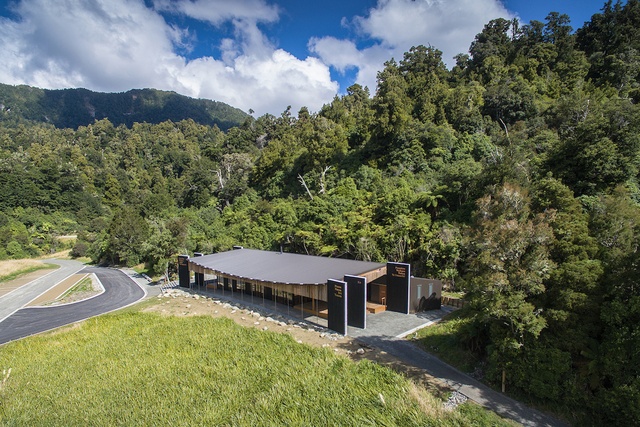
Hugh Tennent, from Wellington practice Tennent Brown Architects, further explains the concept and process of designing Te Wharehou o Waikaremoana: “We started with a lot of research in terms of the history and setting, but it was really about forming relationships with some very interesting characters – Tūhoe are known to be independent thinkers. Ivan and Jasmax had done the concept design and spatial planning so we did a review and took some of their recommendations, making it a little less rectilinear with a softer, draping roof. We added pou at each end to give a sense of occupation and standing in the place, a reflection of the geomorphology of Onepoto – massive vertical sandstone slabs [located nearby]. The concept refers to these big slabs and, in between that, the roof acts like a basin, a metaphor of the lake.”
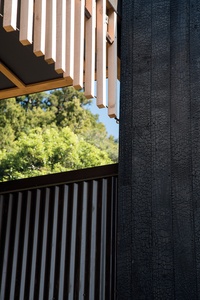
The Onepoto Caves were formed by the same upheaval that created Lake Waikaremoana some 2,200 years ago, when the Waikaretaheke River was dammed by a huge landslide, probably triggered by an earthquake, and water filled the valley. When siting the building, “there was a risk of lateral-spread liquefaction because it sits on an old lake bed; so, big screw piles were inserted and the wooden floor is lifted off the ground to gain an aspect over the lake,” states Tennent.
The central idea of Te Wharehou is to connect people with the lake, the environment and the neighbouring DOC holiday park. Tennent describes it as “much less of a shop and more of a conversation place”. Visitors can enter the building at each end. Generous decks wrap around three sides of the building – facing west, north and east – providing a respite from the rain. “Visitors can feel welcome and sheltered at the end of a tramp,” explains Tennent. “We set it up like a pōwhiri at the eastern end, and you can come up from the holiday park at the other end, and also sun yourself along the verandah at the front.”
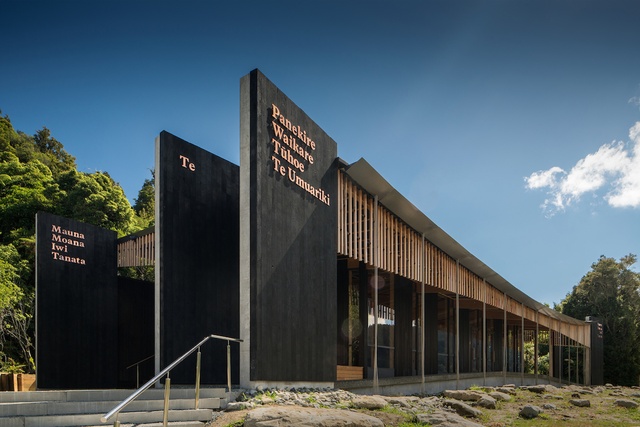
Along the northern façade, twisting cables fall down from the gutters, conceptually forming streams from the roof into the wetlands in front of the building. Around the perimeter of the structure, timber screening in local tōtara intentionally filters light into the interior – similar to the dappled light you might experience while walking through a forest.
The curved roof is simply formed by lowering the beams and adjusting the column legs to go down and then back up again. The concrete pou at each end of the building are over-clad in burnt wood, expressing the concept of the ‘home fire’, which is an important concept for Tūhoe and relates to occupation and dwelling.
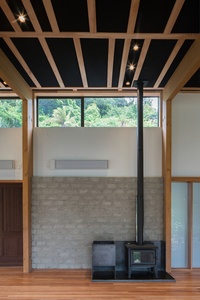
To further express this notion, WTA was keen to create a cosy atmosphere during the middle of winter when snow can fall around the lake. “One of the ideas of the building is to create a warmth to welcome visitors inside” says Taylor. “There’s a fireplace for warmth, the entrance is an area of welcoming and there’s a space to eat, like a wharenui [communal house].”
The central wall behind the fireplace is constructed by local iwi from earth bricks left over from Te Kura Whare (the clay was extracted at Taneatua), adding a connection between the local people to the tribal office. “Feeling connected to our tribal is very important to us,” explains Taylor.
The multi-purpose space is arranged to overlook the lake, with offices sitting in behind. The dark patterned ceiling offers a sense of ‘presence’, as well as aiding the acoustics. Local and recycled timber add warmth to the space, as do the crafted elements. Pale matai has been re-purposed from sarking taken from the ceiling at Āniwaniwa, seen here in the flooring and bespoke tables.
Te Kura Whare at Taneatua was designed and built under the Living Building Challenge (LBC) but, in this setting, some LBC drivers didn’t seem appropriate, especially in relation to net zero waste, energy and water. “The lake itself is a giant battery that has already paid off its carbon,” explains Tennent. “DOC had already installed water and sewage lines for the holiday park so we plugged into that, rather than the expense of solar panels and tanks, etc.
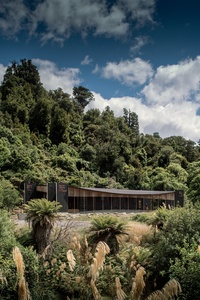
However, the materials were driven by LBC criteria: “This materials palette is one of the hardest we’ve done, which required hundreds of hours of research; the printed tracking sheet is probably 7m long. There are no [LBC] Red List materials in this building,” states Tennent.
“Tūhoe [people] have a strong streak of pragmatism. They have to as it’s not the easiest environment to be in; so we needed to keep maintenance costs low as, in this location, the cost and time involved with bringing in an electrician is challenging. It takes ages to fix things so we kept the systems easy.”
Taylor believes that the natural environment has its own way of looking after itself. “If we can look after ourselves, then we can look after Te Uruwera. This is an opportunity, through Te Kawa o Te Urewera [management draft], to create a unique experience; we have never really had that opportunity before – through alienation. This is our life now, our norm. Having this building supports all those things we want to do. This is such a beautiful space. We can look out towards bush and upon our lake and we like sharing it with people, with visitors who come in and want to know what its about; they are in no rush to leave. You can enjoy your time here – and for generations to come. It is important to carry that through to future generations. It’s a connector.”
REFERENCES
1. Department of Conservation website
3. Dr Vincent O’Malley’s website
FURTHER READING
4. Encircled Lands: Te Urewera, 1820-1921 by
Judith Binney; Bridget Riley Books; 2009.
‘Summary of the Ngāi Tūhoe Settlement’

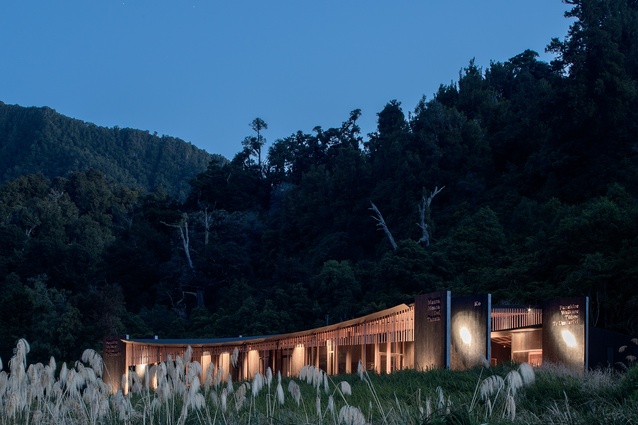
![The open space has three main areas: a café and kitchen, and a dining area and a welcoming area, which can both be used for formal and informal wānanga [discussion].](https://cdn.architecturenow.co.nz/site_media/media/cache/b3/ed/b3ed79023ba9b6f0e74413fc7b37557f.jpg)
